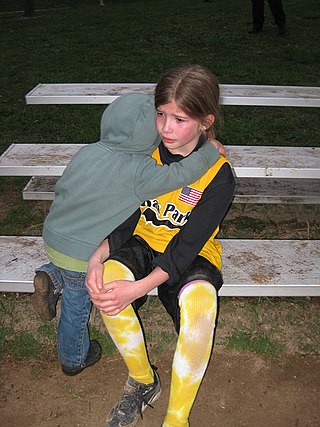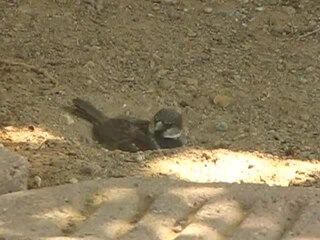
The chicken is a domesticated species that arose from the red junglefowl, originally from India. They have also partially hybridized with other wild species of junglefowl. Rooster and cock are terms for adult male birds, and a younger male may be called a cockerel. A male that has been castrated is a capon. An adult female bird is called a hen, and a sexually immature female is called a pullet. Humans keep chickens primarily as a source of food or as pets. Traditionally, they were also bred for cockfighting, which is still practiced in some places. Chickens domesticated for meat are broilers, and for eggs, they are layers.

Debeaking, beak trimming, or beak conditioning is the partial removal of the beak of poultry, especially layer hens and turkeys although it may also be performed on quail and ducks. Most commonly, the beak is shortened permanently, although regrowth can occur. The trimmed lower beak is somewhat longer than the upper beak. A similar but separate practice, usually performed by an avian veterinarian or an experienced birdkeeper, involves clipping, filing or sanding the beaks of captive birds for health purposes – in order to correct or temporarily to alleviate overgrowths or deformities and better allow the bird to go about its normal feeding and preening activities. Amongst raptor-keepers, this practice is commonly known as "coping".

The domestic turkey is a large fowl, one of the two species in the genus Meleagris and the same species as the wild turkey. Although turkey domestication was thought to have occurred in central Mesoamerica at least 2,000 years ago, recent research suggests a possible second domestication event in the area that is now the southwestern United States between 200 BC and AD 500. However, all of the main domestic turkey varieties today descend from the turkey raised in central Mexico that was subsequently imported into Europe by the Spanish in the 16th century.

Empathy is the capacity to understand or feel what another person is experiencing from within their frame of reference, that is, the capacity to place oneself in another's position. Definitions of empathy encompass a broad range of social, cognitive, and emotional processes primarily concerned with understanding others. Types of empathy include cognitive empathy, emotional empathy, somatic empathy, and spiritual empathy.

Breed broiler is any chicken that is bred and raised specifically for meat production. Most commercial broilers reach slaughter weight between four and six weeks of age, although slower growing breeds reach slaughter weight at approximately 14 weeks of age. Typical broilers have white feathers and yellowish skin. Broiler or sometimes broiler-fryer is also used sometimes to refer specifically to younger chickens under 2.0 kilograms, as compared with the larger roasters.

Emotion is defined as any mental experience with high intensity and high hedonic content. The existence and nature of emotions in non-human animals are believed to be correlated with those of humans and to have evolved from the same mechanisms. Charles Darwin was one of the first scientists to write about the subject, and his observational approach has since developed into a more robust, hypothesis-driven, scientific approach. Cognitive bias tests and learned helplessness models have shown feelings of optimism and pessimism in a wide range of species, including rats, dogs, cats, rhesus macaques, sheep, chicks, starlings, pigs, and honeybees. Jaak Panksepp played a large role in the study of animal emotion, basing his research on the neurological aspect. Mentioning seven core emotional feelings reflected through a variety of neuro-dynamic limbic emotional action systems, including seeking, fear, rage, lust, care, panic and play. Through brain stimulation and pharmacological challenges, such emotional responses can be effectively monitored.

Battery cages are a housing system used for various animal production methods, but primarily for egg-laying hens. The name arises from the arrangement of rows and columns of identical cages connected, in a unit, as in an artillery battery. Although the term is usually applied to poultry farming, similar cage systems are used for other animals. Battery cages have generated controversy between advocates for animal welfare and industrial producers.

Displacement activities occur when an animal experiences high motivation for two or more conflicting behaviours: the resulting displacement activity is usually unrelated to the competing motivations. Birds, for example, may peck at grass when uncertain whether to attack or flee from an opponent; similarly, a human may scratch their head when they do not know which of two options to choose. Displacement activities may also occur when animals are prevented from performing a single behaviour for which they are highly motivated. Displacement activities often involve actions which bring comfort to the animal such as scratching, preening, drinking or feeding.

Poultry farming is the form of animal husbandry which raises domesticated birds such as chickens, ducks, turkeys and geese to produce meat or eggs for food. Poultry – mostly chickens – are farmed in great numbers. More than 60 billion chickens are killed for consumption annually. Chickens raised for eggs are known as layers, while chickens raised for meat are called broilers.

Dust bathing is an animal behavior characterized by rolling or moving around in dust, dry earth or sand, with the likely purpose of removing parasites from fur, feathers or skin. Dust bathing is a maintenance behavior performed by a wide range of mammalian and avian species. For some animals, dust baths are necessary to maintain healthy feathers, skin, or fur, similar to bathing in water or wallowing in mud. In some mammals, dust bathing may be a way of transmitting chemical signals to the ground which marks an individual's territory.

Feather pecking is a behavioural problem that occurs most frequently amongst domestic hens reared for egg production, although it does occur in other poultry such as pheasants, turkeys, ducks, broiler chickens and is sometimes seen in farmed ostriches. Feather pecking occurs when one bird repeatedly pecks at the feathers of another. The levels of severity may be recognized as mild and severe. Gentle feather pecking is considered to be a normal investigatory behaviour where the feathers of the recipient are hardly disturbed and therefore does not represent a problem. In severe feather pecking, however, the feathers of the recipient are grasped, pulled at and sometimes removed. This is painful for the receiving bird and can lead to trauma of the skin or bleeding, which in turn can lead to cannibalism and death.

Abnormal behavior of birds in captivity has been found to occur among both domesticated and wild birds. Abnormal behavior can be defined in several ways. Statistically, 'abnormal' is when the occurrence, frequency or intensity of a behaviour varies statistically significantly, either more or less, from the normal value. This means that theoretically, almost any behaviour could become 'abnormal' in an individual. Less formally, 'abnormal' includes any activity judged to be outside the normal behaviour pattern for captive birds of that particular class or age. For example, running rather than flying may be a normal behaviour and regularly observed in one species, however, in another species it might be normal but becomes 'abnormal' if it reaches a high frequency, or in another species it is rarely observed and any incidence is considered 'abnormal'. This article does not include 'one-off' behaviours performed by individual birds that might be considered abnormal for that individual, unless these are performed repeatedly by other individuals in the species and are recognised as part of the ethogram of that species.
Vent pecking is an abnormal behaviour of birds performed primarily by commercial egg-laying hens. It is characterised by pecking damage to the cloaca, the surrounding skin and underlying tissue. Vent pecking frequently occurs immediately after an egg has been laid when the cloaca often remains partly everted exposing the mucosa, red from the physical trauma of oviposition or bleeding if the tissue is torn by her laying an egg. Vent pecking clearly causes pain and distress to the bird being pecked. Tearing of the skin increases susceptibility to disease and may lead to cannibalism, with possible evisceration of the pecked bird and ultimately, death.
Animal welfare science is the scientific study of the welfare of animals as pets, in zoos, laboratories, on farms and in the wild. Although animal welfare has been of great concern for many thousands of years in religion and culture, the investigation of animal welfare using rigorous scientific methods is a relatively recent development. The world's first Professor of Animal Welfare Science, Donald Broom, was appointed by Cambridge University (UK) in 1986.

Cannibalism in poultry is the act of one individual of a poultry species consuming all or part of another individual of the same species as food. It commonly occurs in flocks of domestic hens reared for egg production, although it can also occur in domestic turkeys, pheasants and other poultry species. Poultry create a social order of dominance known as pecking order. When pressure occurs within the flock, pecking can increase in aggression and escalate to cannibalism. Cannibalism can occur as a consequence of feather pecking which has caused denuded areas and bleeding on a bird's skin. Cannibalism can cause large mortality rates within the flock and large decreases in production due to the stress it causes. Vent pecking, sometimes called 'cloacal cannibalism', is considered to be a separate form of cannibalistic pecking as this occurs in well-feathered birds and only the cloaca is targeted. There are several causes that can lead to cannibalism such as: light and overheating, crowd size, nutrition, injury/death, genetics and learned behaviour. Research has been conducted to attempt to understand why poultry engage in this behaviour, as it is not totally understood. There are known methods of control to reduce cannibalism such as crowd size control, beak trimming, light manipulation, perches, selective genetics and eyewear.

Broodiness is the action or behavioral tendency to sit on a clutch of eggs to incubate them, often requiring the non-expression of many other behaviors including feeding and drinking. Being broody has been defined as "Being in a state of readiness to brood eggs that is characterized by cessation of laying and by marked changes in behavior and physiology".. Broodiness is usually associated with female birds, although males of some bird species become broody and some non-avian animals also show broodiness.

Comfort behaviours in animals are activities that help maintain the pelage, feathers, integuement or musculoskeletal system and increase the physical comfort of the animal.
Emotional intelligence (EI) involves using cognitive and emotional abilities to function in interpersonal relationships, social groups as well as manage one's emotional states. It consists of abilities such as social cognition, empathy and also reasoning about the emotions of others.

Compassion fade is the tendency to experience a decrease in empathy as the number of people in need of aid increase. As a type of cognitive bias, it has a significant effect on the prosocial behaviour from which helping behaviour generates. The term was developed by psychologist and researcher Paul Slovic.
Christine Nicol is an author, academic and a researcher. She is a Professor of Animal Welfare at the Royal Veterinary College and has honorary appointments at the University of Oxford and the University of Lincoln. She is the Field Chief Editor of Frontiers in Animal Science.
















